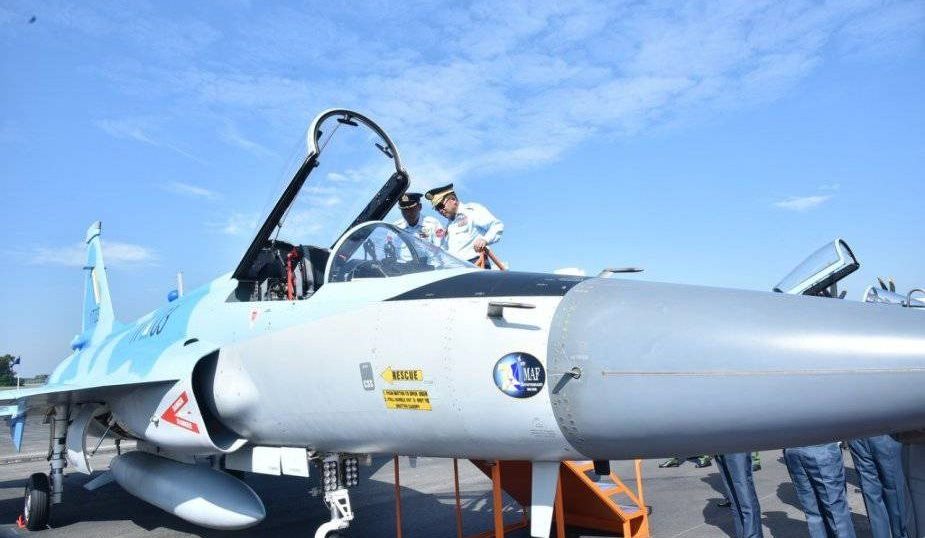---
# Technical Problems Ground Myanmar’s JF-17 Fighter Jets Bought From China
## Excerpt
> The $25-million jets arrived with structural problems but post-coup sanctions and a lack of local expertise make it impossible to fix them, ex-Air Force pilots say.
Regime chief Min Aung Hlaing inspects a JF-17 at an airbase.
By The Irrawaddy 25 November 2022
Most of the newly acquired Chinese and Pakistan-made JF-17 fighter jets that the Myanmar regime has taken delivery of have been grounded due to technical malfunctions, according to analysts and former Myanmar Air Force pilots who monitor the junta’s air capabilities.
The JF-17 fighters—lightweight multi-role combat aircraft jointly manufactured by China and Pakistan—that the Myanmar Air Force has added to its fleet have structural cracks and other technical issues, they told The Irrawaddy.
The aircraft, which are supposed to be capable of interception, ground attack and bombing missions, have turned out to be unfit for service, and the Myanmar military lacks the technical expertise to fix the problems, they added.
Myanmar reportedly inked a deal in early 2016 to procure 16 JF-17s from China at a cost of US$25 million each. A first batch of six aircraft were delivered to the Myanmar Air Force in 2018, but details about the other 10 are not yet clear. The deal made Myanmar the first country outside China and Pakistan to buy JF-17s.

Aircraft including four JF-17 Thunder fighters are officially commissioned into the Myanmar Air Force in 2018.
Myanmar regime chief Min Aung Hlaing put four of the malfunctioning JF-17 fighters into commission at a ceremony at the Meiktila air base in December 2018. Two more were commissioned in December 2019 as the Air Force celebrated the 72nd anniversary of its founding.
Jointly manufactured by Pakistan Aeronautical Complex and Chengdu Aerospace Corporation of China, the JF-17 was initially designed to balance India’s Air Force. They are equipped with Western avionics and powered by the Russian Klimov RD 93 aeroengine, and set up on a China-made airframe, according to analysts. They can be armed with air-to-air mid-range guided missiles, 80-mm and 240-mm rockets, and 500-lb bombs.
The critical part of the JF-17 avionics is the China-made KLJ-7 Al radar, which has poor accuracy and maintenance problems, analysts say. The aircraft does not even have an effective beyond-visual-range (BVR) missile or airborne interception radar.
Malfunction of the Weapon Mission Management Computer has caused launch zones of BVR air-to-air missiles to shrink during combat exercises, according to experts.
Furthermore, the airframe is vulnerable to damage, especially in its wingtips and hardpoints, when the aircraft encounters strong gravitational forces, according to a former pilot of the Myanmar Air Force.
**Problems after purchase**
As the avionics and electronics installed in JF-17s are made with parts from Western countries, the Myanmar military purchased the fighter jets through middlemen between 2015 and 2020. Following the coup, the European Union imposed sanctions against the Myanmar military and arms brokers, and the Air Force now has no spare parts for the JF-17s, according to analysts and former pilots.
The trade embargo also makes it impossible for the Myanmar military regime to directly buy missiles and bombs for its JF-17s. The regime meanwhile has forged a partnership with the Pakistan military, sending weapons system officers from the Air Force and Air Defense units to Pakistan for training from time to time.
For the Myanmar Air Force to carry out deadly air strikes on ethnic armed revolutionary organizations and civilians, it mainly needs air-to-surface missiles, and it reportedly held talks with Pakistan to order these as well as bombs and rockets. Around May this year, a cargo plane from Pakistan loaded with JF-17 spare parts landed in Myanmar.
Technicians from the Pakistan Air Force made a secret visit to Myanmar in September during which they set up a JF-17 simulator for pilots of the Myanmar Air Force at Pathein air base, and also solved some technical problems. A JF-17 weapons system officer however said the weapons system of the JF-17 is too technically complex for Myanmar pilots to handle, according to former pilots.
**Current situation**
A JF-17
Thanks to the JF-17s’ poor accuracy, the Myanmar Air Force still can’t use them for combat four years after they were commissioned. This has led the Air Force to rely on Russian-made Yak-130 and MiG-29 fighter jets and China-made K-8 fighters, said analysts.
While the Myanmar Air Force has spent a large sum to procure malfunctioning aircraft from China and Pakistan, arms broker Dr. Naing Htut Aung has earned millions of US dollars from the deal, The Irrawaddy has learned.
At the 72nd anniversary event for the Myanmar Air Force, Min Aung Hlaing boasted that the Myanmar Air Force started with Tiger Moth planes, but now has hangars filled with modern aircraft including supersonic jet fighters, transportation aircraft, and assault and transportation helicopters.
He made no mention of the Air Force’s unusable JF-17 fighters.


